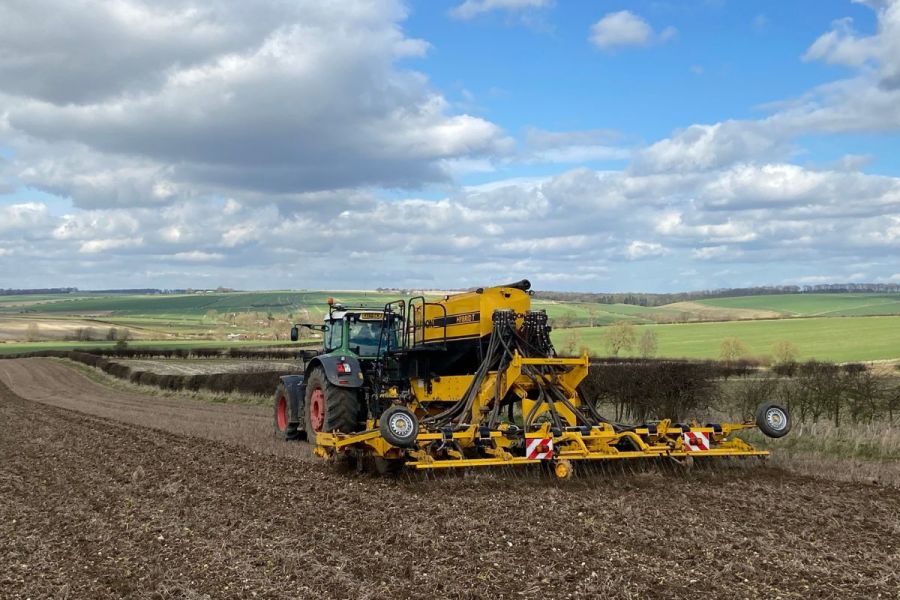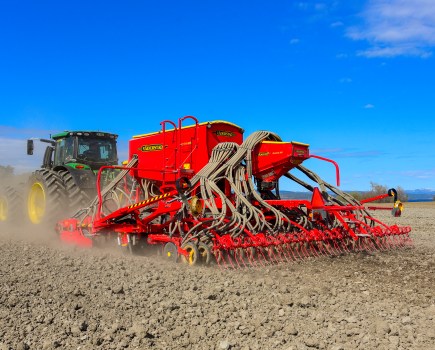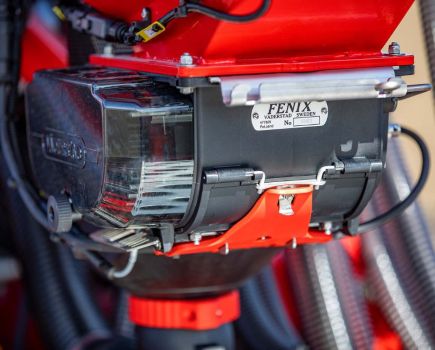As CPM’s first issue dropped onto doormats, Suffolk farmer Jeff Claydon, already a successful yield-monitoring equipment manufacturer, was beginning to rethink his crop establishment to address falling returns. CPM reviews the evolution of Claydon products and the company’s business.
“From our beginnings 20 years ago when users simply wanted to put a seed in the ground, we can now help them place multiple seeds, fertiliser and micronutrients in one pass.”
By Martin Rickatson
Just two years after CPM was first published in the late 1990s, UK wheat prices plummeted having been exposed to an oversupplied world market. It was the catalyst for significant change in farming techniques, as many growers sought to share machinery and cut establishment expenditure by making fewer passes.
It was this scene that set Suffolk farmer Jeff Claydon to consider ways to maintain decent margins, especially with input prices – particularly fuel – heading in the opposite direction. Having in 1980 invented and introduced the combine auger-mounted Yield-o-Meter measuring device, he already had product development and marketing experience.
“When direct drilling was first tried in the 1970s, burning stubbles provided a clean start – while we had Gramoxone (paraquat) it wasn’t until 1974 that Roundup (glyphosate) was launched,” points out Jeff.
“There was no surface tilth because the fire had removed all moisture, and with no organic matter remaining, worm activity declined. Disc cultivations used to recreate tilth produced powdery soil surfaces that then baked hard, and when it did rain fine, surface soil and ash washed into drill slots, soil cracks and worm holes, preventing water percolation and creating ideal conditions for slugs.
“We tried both disc and tine drills, finding the latter performed better on our heavier soils, but depending on the conditions, the results were either fantastic or disastrous,” he continues.
As wheat prices rose in the early 1980s aided by intervention, like many others, the Claydons returned to ploughing, but burning of spread straw often continued to aid residue management and weed and pest control.
“This meant we still weren’t feeding the worms and the soil, and even after moving to chopping before the 1993 straw-burning ban, soil surfaces often remained anaerobic with insufficient oxygen to break down the straw. And because we were often ploughing early as workloads grew, we were incorporating prime blackgrass seed and levels started to increase.
“But we had a broad herbicide armoury, cheap diesel and good commodity prices, and by the mid-90s we’d developed the market for the plough-mounted Furrow Cracker, which helped initial break-down of heavy land for conventional drilling.”
However, the EU move in the early 2000s to reduce intervention purchases as a method of price support, saw commodity prices drop heavily to world levels. “That made multiple-pass cultivation systems unviable and led to equipment-sharing and consolidating of operations,” recalls Jeff.
Through his family’s 1970s direct drilling period, he’d experienced its pros and cons. But it was seeing a neighbouring farmer’s subsoiler-sown oilseed rape in the late 1990s which convinced Jeff that coulter type and arrangement were key to direct drill success.
“A neighbour established OSR using a subsoiler in a field adjoining one of ours that we’d drilled following multiple passes. In November ours looked the better crop, but by February his did, and the length of its tap roots was impressive.
“I decided to create a drill using similar principles but with a leading breaker tine for creating tilth that’d allow the passage of roots and water, followed by an A-share with coulter for seed placement on clean soil with 30cm row spacing to improve ground coverage, all on a V-shaped frame to aid trash flow.
“Originally I tried 200mm/8in A-shares, but after a 50-yard test-run the prototype drill blocked. I cut the A-shares down to 125mm/5in, realising we had to move only the soil in the rows to give the plants sufficient rooting room and leave the land between unmoved, cutting fuel use and supporting subsequent traffic,” he explains.
According to Jeff, pre-production trials impressed, aided by higher soil organic matter levels from a decade of ploughing-in chopped straw.
“Establishment straight behind the combine significantly cut the time involved and accelerated emergence and early growth because we were planting into undisturbed moist topsoil. My agronomist initially suggested I was mad, but after seeing the OSR crop again in November he reckoned it was the best on his patch.
“Another company agronomist suggested trying drilling some wheat the same way, so we trialled a split-field, half sown into unmoved ground and half into ploughed/cultivated land. I wasn’t convinced given the surface straw load and initially it didn’t look good.
“It came on well though and by spring there was no clear difference. The next year, while we’d continued establishing second wheats starting with the plough, this time we drilled half directly.”
Jeff says that harvest, having seen no yield difference, they switched the entire farm to the system. “By 2002-03, with neighbours asking us to supply them with machines, we’d made 12 V-Drills. We sourced key components such as the metering unit and hopper from Sulky, had other parts contract-manufactured, and assembled the machines ourselves.”
In the early years of the Claydon drill’s development, challenges soon arose, acknowledges Jeff. “Because we’d previously been burning, and latterly ploughing and cultivating, slug numbers were low, but by year two or three of direct drilling, while more surface organic material was aiding structure and moisture retention, it was attracting slugs. A farmer friend, Tim Ingles, suggested I try a straw harrow, popular in the USA, as a way of tackling them.
“We purchased one but initially I was unsure – there was little to see after a pass. Sometime afterwards though my brother Frank began drilling second wheat – some into baled ground and some into chopped straw – only some of which had been harrowed after I’d stopped, thinking the harrowing wasn’t achieving anything.
“On the unharrowed ground the drill began blocking, while elsewhere in the field the harrow’s ability to put the straw into the surface and help the worms to harvest it was obvious – it was as if it had been baled. As crops began to emerge, we saw further benefits from slug egg and weed seedling destruction. From then on I was convinced of harrowing’s value and that we had to offer one alongside the drill,” says Jeff.
At this point, in 2003, Jeff’s eldest son Oliver joined the business following his engineering degree and designed Claydon’s own 7.5m mounted straw harrow, to a low power, high speed format that would carry just a little straw to aid spread and disturb weed seedlings.
Equally, V-Drill production soon reached 80 units and interest grew not only from UK farmers, but also in mainland Europe. With a broader customer base, the drills were tested across a wider range of conditions including some with significant large stone content.
“That underlined the demand for a design that’d handle stonier soils. Oliver and I decided to move to a square rather than V format with more clearance and separate cultivation and seeding frames on a parallel linkage, with the loosening tine depth controlled on one chassis through the tractor linkage, and the seeding tine depth on the second floating chassis governed by the depth wheels. We also moved to bigger tines with spring rather than shearbolt protection and in 2006 launched the update as the SR, for Stone Release,” explains Jeff.
The compromise was its rigid format, restricting widths to 3m or 4m. “We knew larger farms required wider units, while even at 3m the drills were heavy, exacerbated by their length.
“So in 2009 we introduced the Hybrid – blending key V-Drill and SR aspects. Available in shearbolt or auto-reset formats and with a single chassis and a longitudinal hopper, it allowed fitment of wider folding wings to go to 6m.
“My other son, Spencer, joined us to oversee commercial activities having graduated in business management, and a more concerted focus here helped us to triple our turnover, aided by a significant commitment to exhibit at Agritechnica and grow our exports.”
Wider widths meant handling more trash and after reading a New Zealand report on direct drills which suggested 600mm clearance between any two points was the ideal to handle high trash conditions, Oliver designed the new single chassis concept for the Hybrid.
“By moving from the SR’s second floating chassis to a single design, we could create a wider trailed drill with increased stagger, giving the 600mm clearance for optimum trash flow and with a reduced weight,” says Jeff.
“We also replaced the press wheel and small harrow arrangement used for seed firming on the V-Drill with the levelling boards from the SR, aiding the finish particularly on heavier soils by simply filling the slot with loose soil.”
As the Hybrid market evolved, customers sought to do more in a single pass and Claydon added the ability to apply fertiliser, micronutrients and companion crops via split and additional hoppers. A trailed design followed in 2015, taking working widths up to 8m and hopper capacity to 5500 litres.
Other developments included wider straw harrows and the TerraStar surface cultivator, for creating a light seed furrow-filling shallow tilth ahead of drilling into baked-hard soils. The company also developed the TerraBlade, a simple tool for mechanical weeding between band-sown rows to aid other weed control measures.
But drill development didn’t stop there and the next evolution of the mounted range was called, appropriately enough, the Evolution. Launched in 2022, the 3-6m mounted models feature a longer chassis allowing the fitment of leading discs to slice through trash or cover crops, hydraulic depth control, and longer, higher-capacity hoppers, plus the ability to add a further small seed/micronutrient hopper.
“With the introduction of SFI and more focus on things like multi-cropping and seedbed fertilisers, these developments were an obvious step,” says Oliver. “From our beginnings 20 years ago when users simply wanted to put a seed in the ground, now we can help them place multiple seeds, fertiliser and micronutrients in one pass.”
Jeff acknowledges that while the majority have enjoyed success with Claydon-based direct drilling, a small number of farmers have tried it but latterly decided it wasn’t for them.
“Good preparation, alleviating compaction and drainage issues – the driver for launching our own mole plough – plus proper stubble management with the straw harrow and giving the system time to improve the soil, all combine to make it work. Confidence and commitment are crucial. But we recognise we can always improve and every year we try something a little different to investigate new ideas.
“The 2023-24 season tested every system, but minimal passes and low establishment costs helped ours to protect margins,” says Jeff.
Oliver believes government agricultural policy will be a key driver of drill design during the next 25 years. “We already have the features to enable fertiliser placement and cover crop establishment. Robotics and automation may also become more significant, and our equipment may have to integrate with such systems.”
The past 25 years have seen the loss of many crop protection products, notes Jeff, but farmers have adapted and adjusted.
“Who knows whether we’ll still have glyphosate in another 25 years. I think the roles of machine tech and crop blends will grow significantly and with our latest drills now incorporating the ability to place crop, companion, fertiliser and crop protection products in one pass, I think we have a design set for the challenges of the coming quarter-century.”
This article was taken from the latest issue of CPM. For more articles like this, subscribe here.
Sign up for Crop Production Magazine’s FREE e-newsletter here.




